1990 VOLKSWAGEN TRANSPORTER seats
[x] Cancel search: seatsPage 4 of 165

Downloaded from www.Manualslib.com manuals search engine
1
INSTRUMENT PANEL
Illustration instruments and controls
Warning and indicator light symbols
CONTROLS AND EQUIPMENT
Keys,
central locking system .... 7, 8
Doors 9
Rear lid 11
Windows, mirrors 12, 13 Safety belts, head restraints . . . .14,19
Seats 20 Luggage compartment, pedals . 28,29
Brakes, Transmission 29, 32 Differential lock 33
Automatic-transmission 35 Steering lock/ignition/starter switch . 38
Starting procedures 39 Instrument cluster 40
Warning/indicator lights 43 Switches 46 Emergency flasher 46
Light switch, turn signals .... 46,48
Cruise control 49
Windshield wipers 50 Ventilation/Heating 51
Air conditioning 54
Heater 57
Sliding roof 62
Roof-rack 68 VEHICLE OPERATION
Break-in period - and afterwards . . 69
Operate your vehicle safety 70
Operate your vehicle economically
and minimize pollution 72
Trailer towing 73 Driving with the all-wheel drive ... 75
VEHICLE CARE
Fuel tank, fuel supply 85,86
Vehicle care (exterior/interior) . . 90, 93 Maintenance, inspection intervals . . 95 Engine compartment lid,
engine compartment 97 Lubricants, engine oil 98,99
Engine oil filter 101
Transmission oil 102
Power steering 103
Cooling system 104 Brake fluid 108
Battery 109
Windshield washers/wipers . . . 112,113
Tires/wheels 114 Difficult operating conditions .... 120
Winter driving 121
Accessories 122
DO-IT-YOURSELF SERVICE
Jack and tools 123 Spare wheel 124
Changing a wheel 125 Fuses, bulbs 128, 130 Adjusting headlights
134
Installing,
replacing the radio . . . . 135
Emergency starting 136
Emergency towing 138
Lifting vehicle . . 140
TECHNICAL DESCRIPTION
Engine, transmission 142
Steering,
suspension, brakes,
body, chassis 143 Emission-control-system 144
TECHNICAL DATA
Engine, spark plugs .
V-belts capacities . . Dimensions
Weights
Vehicle identification 146
147
148
150 151
CONSUMER INFORMATION
Service manuals 152
GAS STATION INFORMATION
Location of servicing points 156
ALPHABETICAL INDEX 158
www.westfaliaT3.info - a useful website for owners and enthusiasts of VW Westfalia T25 / T3 Campervans
Page 15 of 165
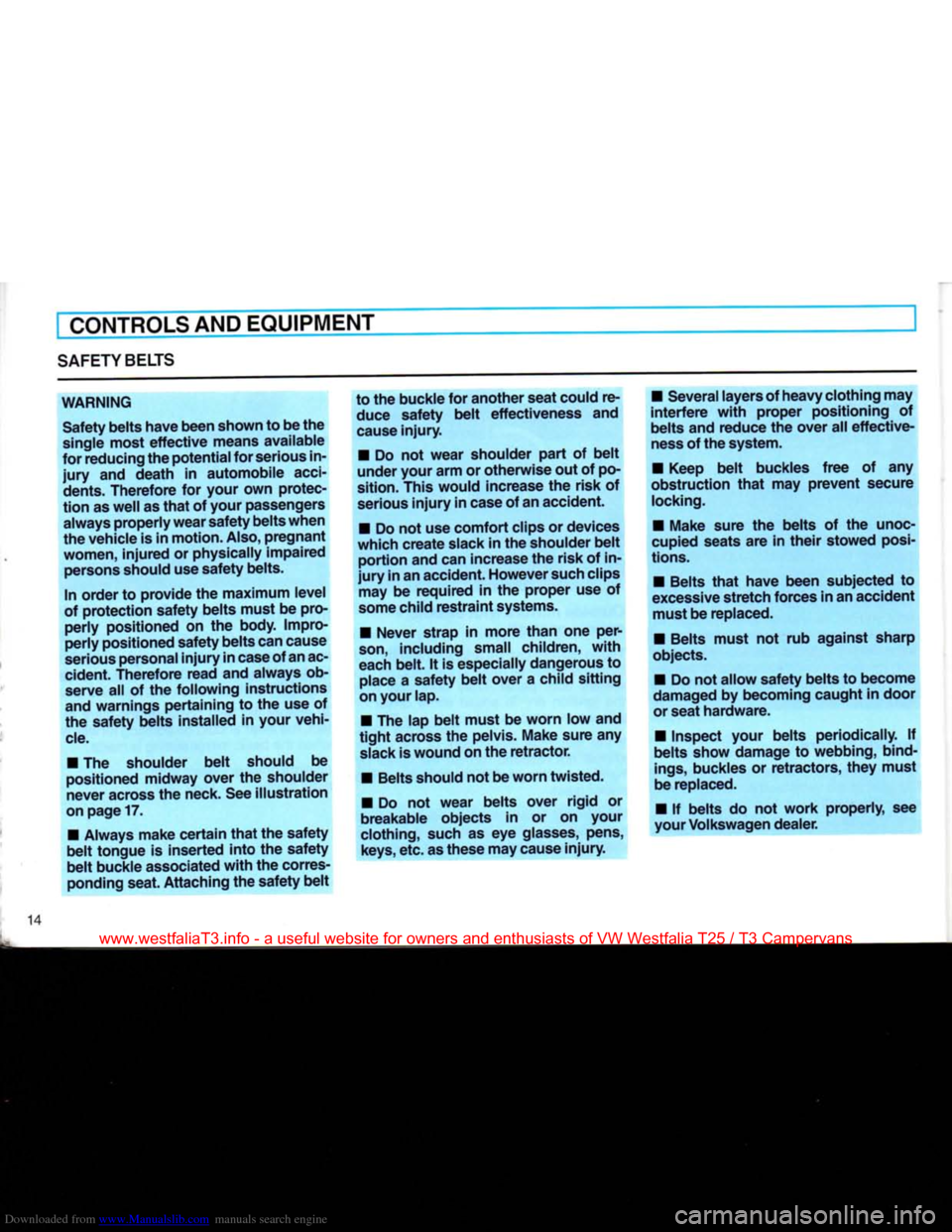
Downloaded from www.Manualslib.com manuals search engine
CONTROLS
AND
EQUIPMENT
SAFETY
BELTS
WARNING Safety belts have been shown to be the
single most effective means available
for reducing the
potential
for serious in
jury
and death in automobile
acci
dents.
Therefore
for
your
own protec
tion as well as that of
your
passengers always properly wear safety
belts
when
the vehicle is in
motion.
Also, pregnant
women,
injured or physically impaired persons should use safety belts.
In order to provide the maximum level
of protection safety belts must be pro perly positioned on the
body.
Impro
perly positioned safety belts
can
cause
serious personal
injury
in
case
of
an
ac
cident.
Therefore
read and always ob serve all of the following instructions
and warnings pertaining to the use of
the safety belts installed in
your
vehi
cle.
•
The shoulder belt should be
positioned midway
over
the shoulder
never
across the neck. See illustration
on page
17.
•
Always make certain that the safety
belt tongue is inserted into the safety
belt buckle associated with the corres
ponding seat. Attaching the safety belt to the buckle for another seat could re
duce safety belt effectiveness and
cause
injury.
•
Do not wear shoulder part of belt
under
your
arm
or otherwise out of po
sition.
This
would increase the risk of
serious
injury
in case of
an
accident.
•
Do not use comfort clips or devices
which create slack in the shoulder belt portion and can increase the risk of in
jury
in an accident.
However
such clips may be required in the proper use of
some
child restraint systems.
•
Never
strap in more than one per
son,
including
small
children, with
each
belt. It is especially dangerous to
place
a safety belt
over
a child sitting
on
your
lap.
•
The lap belt must be
worn
low and
tight across the pelvis. Make sure any
slack
is wound on the retractor.
•
Belts should not be
worn
twisted.
•
Do not wear belts
over
rigid or
breakable
objects in or on
your
clothing,
such as eye glasses, pens,
keys,
etc. as these may cause
injury.
•
Several layers of
heavy
clothing
may
interfere with proper positioning of
belts
and reduce the
over
all effective
ness
of the system.
•
Keep belt buckles free of any
obstruction that may
prevent
secure
locking.
•
Make sure the belts of the unoc
cupied seats are in their stowed posi
tions.
•
Belts that have been subjected to
excessive stretch forces in
an
accident must be replaced.
•
Belts must not rub against sharp
objects.
•
Do not allow safety belts to become
damaged
by becoming caught in door
or seat hardware.
•
Inspect
your
belts periodically. If
belts
show damage to webbing, bind
ings,
buckles or retractors,
they
must
be replaced.
•
If belts do not work properly, see
your
Volkswagen dealer.
www.westfaliaT3.info - a useful website for owners and enthusiasts of VW Westfalia T25 / T3 Campervans
Page 16 of 165
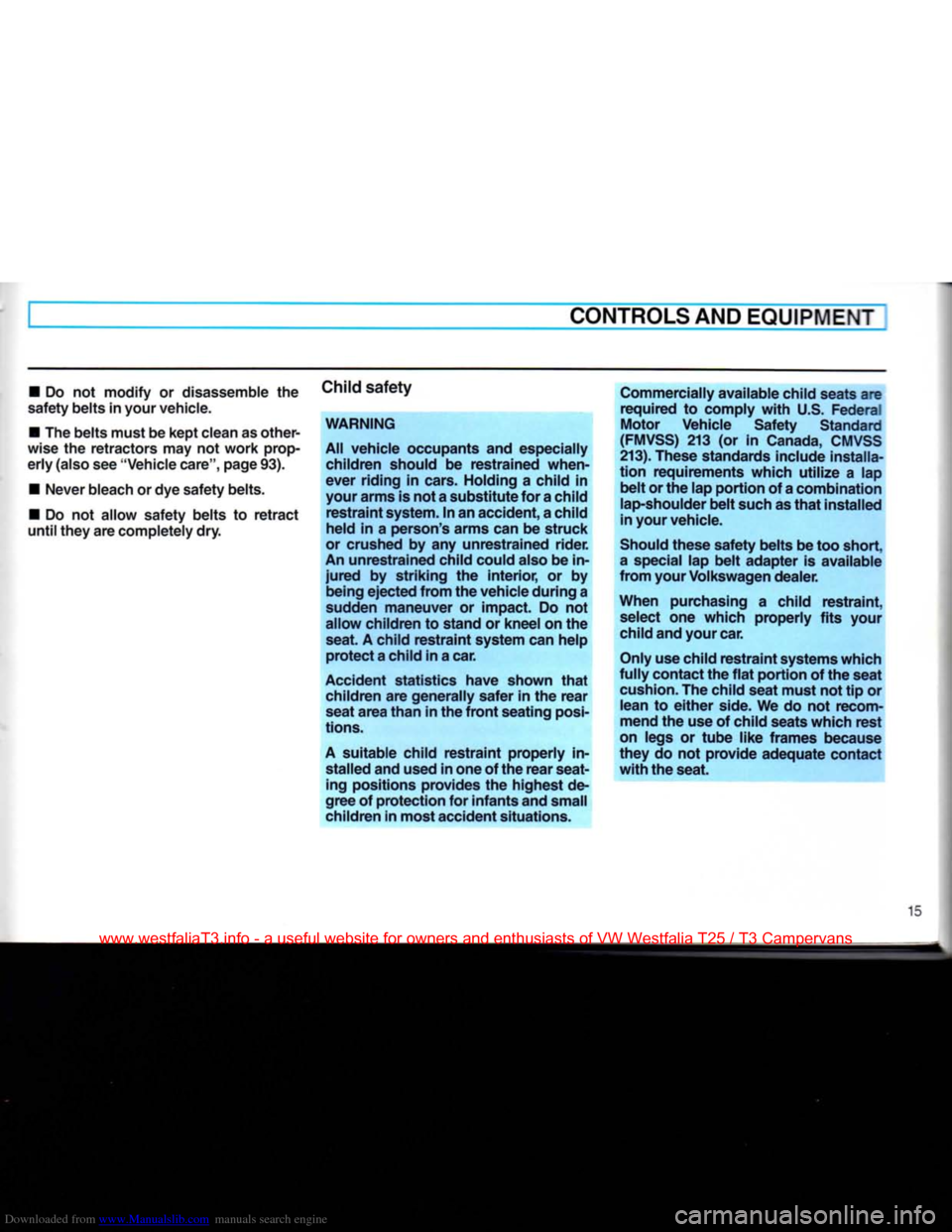
Downloaded from www.Manualslib.com manuals search engine
CONTROLS
AND
EQUIPMENT
• Do not modify or disassemble the
safety belts in
your
vehicle.
• The belts must be kept clean as other
wise the retractors may not work prop
erly
(also see "Vehicle care", page 93).
•
Never
bleach or dye safety belts.
• Do not allow safety belts to retract
until
they
are completely dry. Child safety
WARNING
All
vehicle occupants and especially children should be restrained when
ever
riding in cars. Holding a child in
your
arms is not
a
substitute for
a
child restraint system. In an accident,
a
child
held in a person's arms can be struck
or crushed by any unrestrained rider.
An unrestrained child could also be in
jured
by striking the interior, or by
being
ejected from the vehicle during a
sudden maneuver or impact. Do not
allow children to stand or kneel on the
seat.
A child restraint system can help protect
a
child in
a
car.
Accident statistics have shown that children are generally safer in the rear
seat area than in the
front
seating posi
tions.
A suitable child restraint properly in
stalled
and used in one of the rear seat
ing
positions provides the highest de
gree of protection for infants and
small
children in most accident situations. Commercially available child seats are
required to comply with U.S. Federal
Motor Vehicle Safety Standard
(FMVSS)
213 (or in Canada, CMVSS
213).
These
standards include
installa
tion requirements which utilize a lap belt or the lap portion of
a
combination lap-shoulder belt such as that installed
in
your
vehicle.
Should these safety belts be too short,
a
special lap belt adapter is available
from
your
Volkswagen dealer.
When purchasing a child restraint, select one which properly fits
your
child and
your
car.
Only
use child restraint systems which
fully contact the flat portion of the seat
cushion.
The child seat must not tip or
lean
to either side. We do not recom
mend the use of child seats which rest
on legs or tube
like
frames because
they
do not provide adequate contact
with the seat.
15
www.westfaliaT3.info - a useful website for owners and enthusiasts of VW Westfalia T25 / T3 Campervans
Page 19 of 165
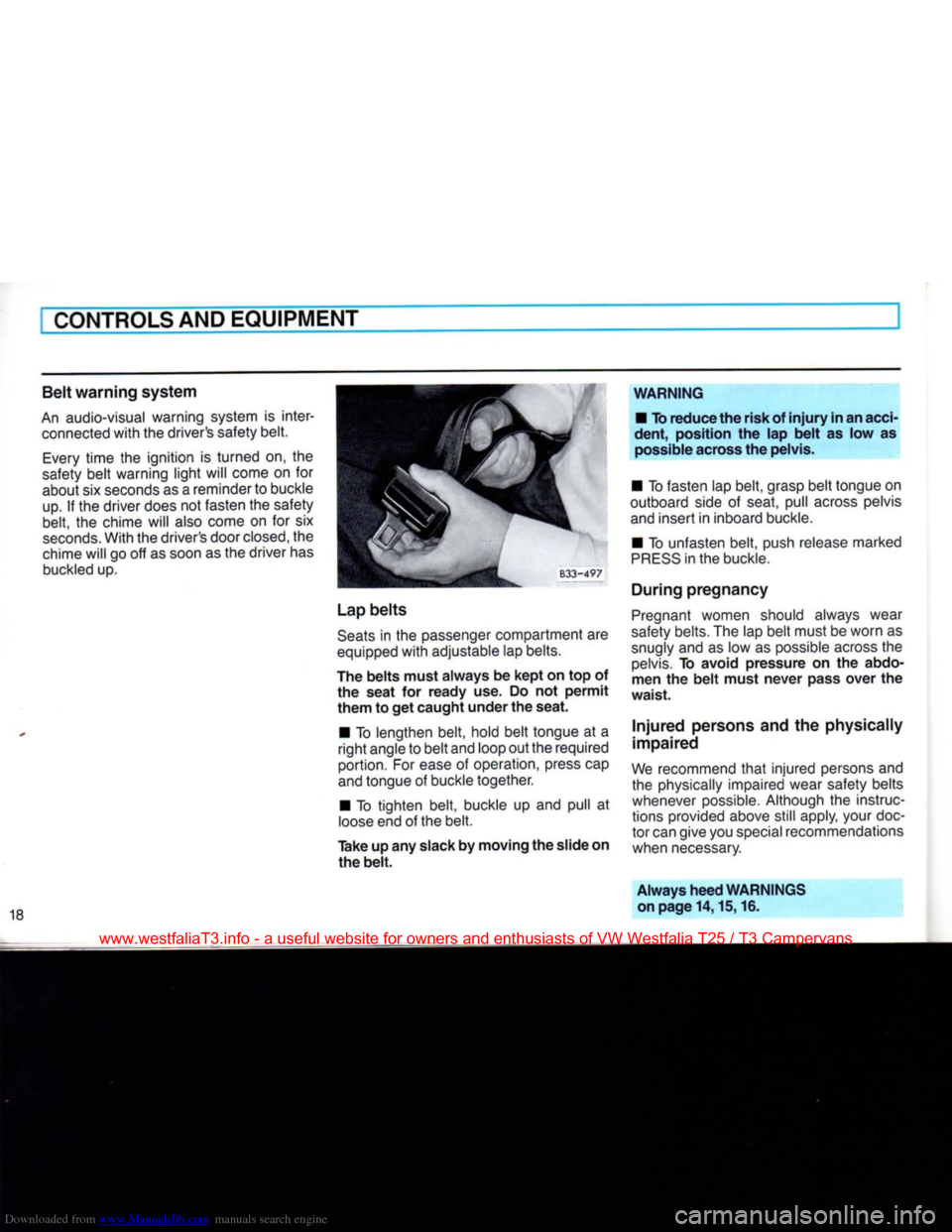
Downloaded from www.Manualslib.com manuals search engine
CONTROLS AND EQUIPMENT
Belt
warning
system
An
audio-visual warning system is inter
connected
with
the driver's safety belt.
Every
time the ignition is turned on, the
safety belt warning light will come on for about six seconds as a reminder to buckle
up.
If the driver does not fasten the safety
belt, the chime will also come on for six
seconds.
With the driver's door
closed,
the
chime will go off as soon as the driver has
buckled
up.
Lap
belts
Seats
in the passenger compartment are
equipped
with
adjustable lap belts.
The
belts
must
always
be
kept
on top of the
seat
for
ready
use. Do not
permit
them
to get
caught
under
the
seat.
• To lengthen belt, hold belt tongue at a
right
angle to belt and loop out the required
portion. For
ease
of operation, press cap
and
tongue of buckle together.
• To tighten belt, buckle up and pull at
loose
end of the belt.
Take
up any slack by
moving
the slide on the
belt.
WARNING
• To
reduce
the
risk
of
injury
in an acci
dent,
position the lap
belt
as low as
possible across the pelvis.
• To fasten lap belt, grasp belt tongue on
outboard side of seat, pull across pelvis
and
insert in inboard buckle.
• To unfasten belt, push release marked
PRESS
in the buckle.
During
pregnancy
Pregnant
women should always wear
safety belts. The lap belt must be worn as
snugly and as low as possible across the
pelvis.
To avoid pressure on the abdo
men the
belt
must
never
pass
over
the
waist.
Injured
persons and the physically
impaired
We
recommend
that
injured persons and the physically impaired wear safety belts
whenever possible. Although the instruc
tions provided above still apply, your doc
tor can give you special recommendations
when necessary.
Always
heed
WARNINGS
on
page
14,15,16.
www.westfaliaT3.info - a useful website for owners and enthusiasts of VW Westfalia T25 / T3 Campervans
Page 20 of 165
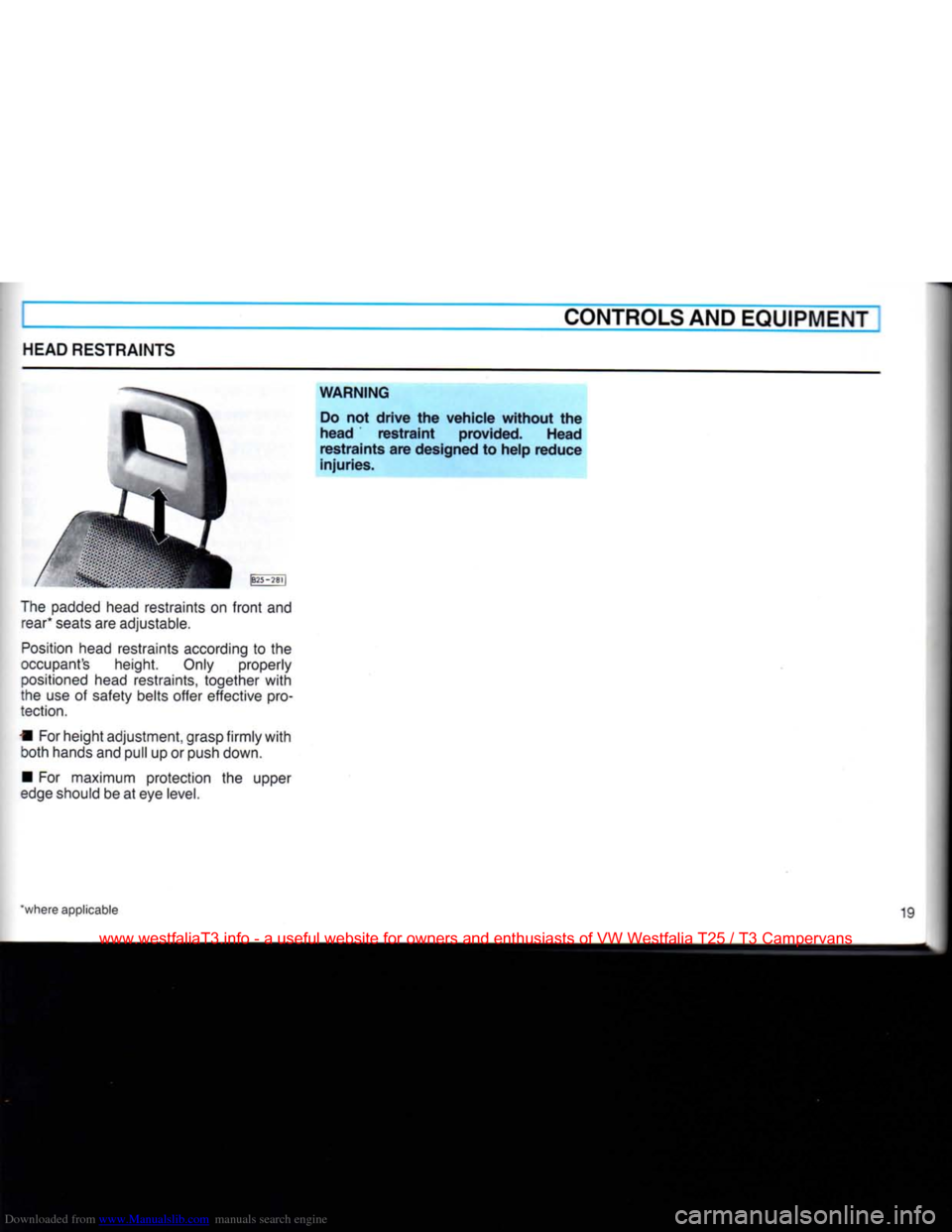
Downloaded from www.Manualslib.com manuals search engine
CONTROLS AND
EQUIPMENT
HEAD
RESTRAINTS
|B25-28l|
The padded head restraints on
front
and rear* seats are adjustable.
Position
head restraints according to the
occupant's height. Only properly positioned head restraints, together
with
the use of safety belts offer effective pro
tection.
• For height adjustment, grasp
firmly
with
both hands and pull up or push down.
• For maximum protection the upper
edge should be at eye
level.
WARNING
Do not
drive
the
vehicle
without
the
head
restraint
provided.
Head
restraints
are designed to
help
reduce
injuries.
"where applicable 19
www.westfaliaT3.info - a useful website for owners and enthusiasts of VW Westfalia T25 / T3 Campervans
Page 21 of 165
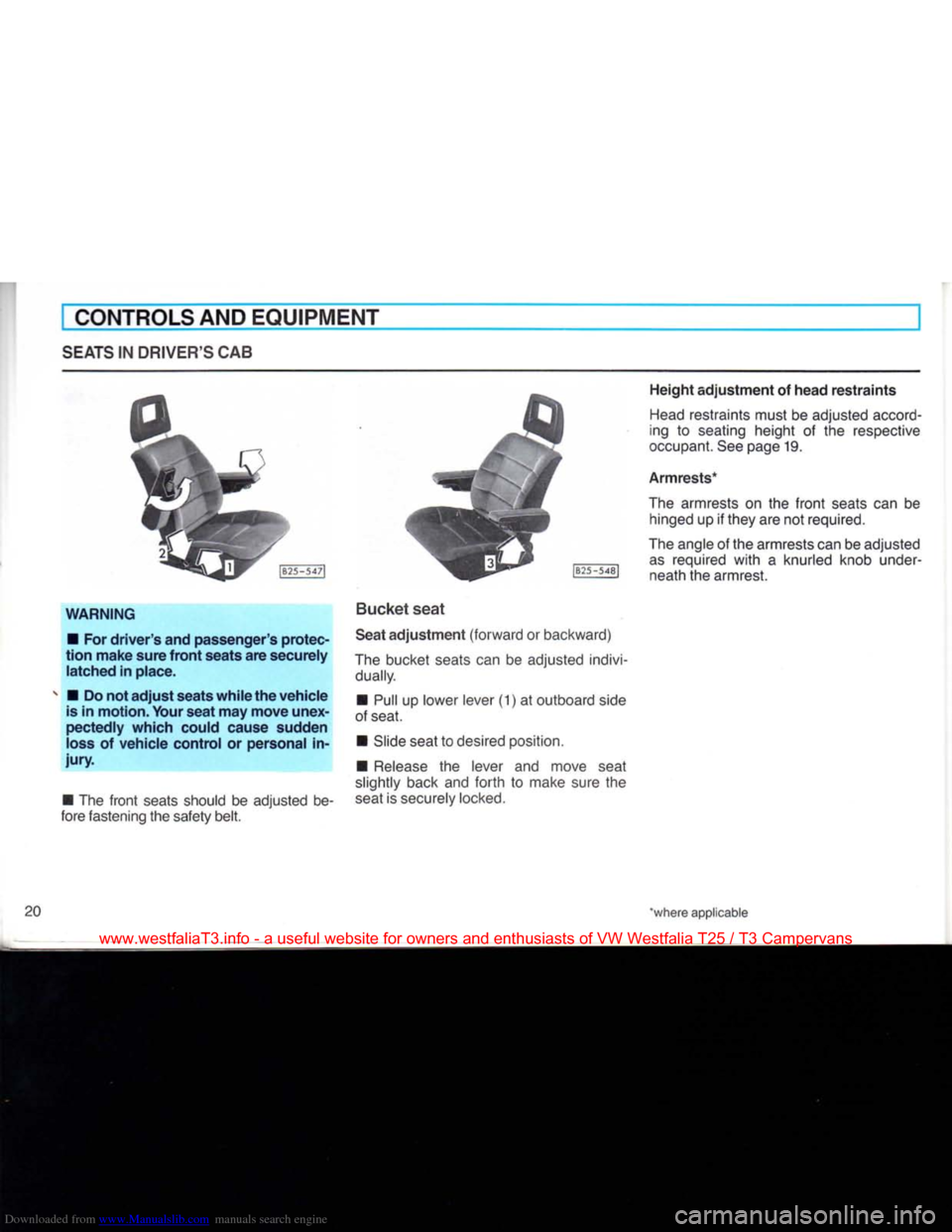
Downloaded from www.Manualslib.com manuals search engine
CONTROLS
AND
EQUIPMENT
SEATS
IN
DRIVER'S
CAB
WARNING
•
For
driver's
and passenger's
protec
tion
make
sure
front
seats
are
securely
latched
in place.
*
• Do not
adjust
seats
while
the
vehicle
is in
motion.
Your
seat
may
move
unex
pectedly
which
could cause sudden
loss of
vehicle
control
or
personal
in
jury.
•
The
front
seats should be adjusted be
fore fastening the safety belt.
B25-548
Bucket
seat
Seat
adjustment
(forward
or backward)
The
bucket seats can be adjusted indivi dually.
•
Pull up lower lever (1) at outboard side
of seat.
•
Slide seat to desired position.
•
Release
the lever and move seat
slightly back and
forth
to make sure the
seat
is securely locked.
Height
adjustment
of
head
restraints
Head
restraints must be adjusted accord
ing to seating height of the respective
occupant. See page 19.
Armrests*
The
armrests on the
front
seats can be hinged up if they are not required.
The
angle of the armrests can be adjusted
as
required
with
a knurled knob underneath the armrest.
*where applicable
www.westfaliaT3.info - a useful website for owners and enthusiasts of VW Westfalia T25 / T3 Campervans
Page 22 of 165
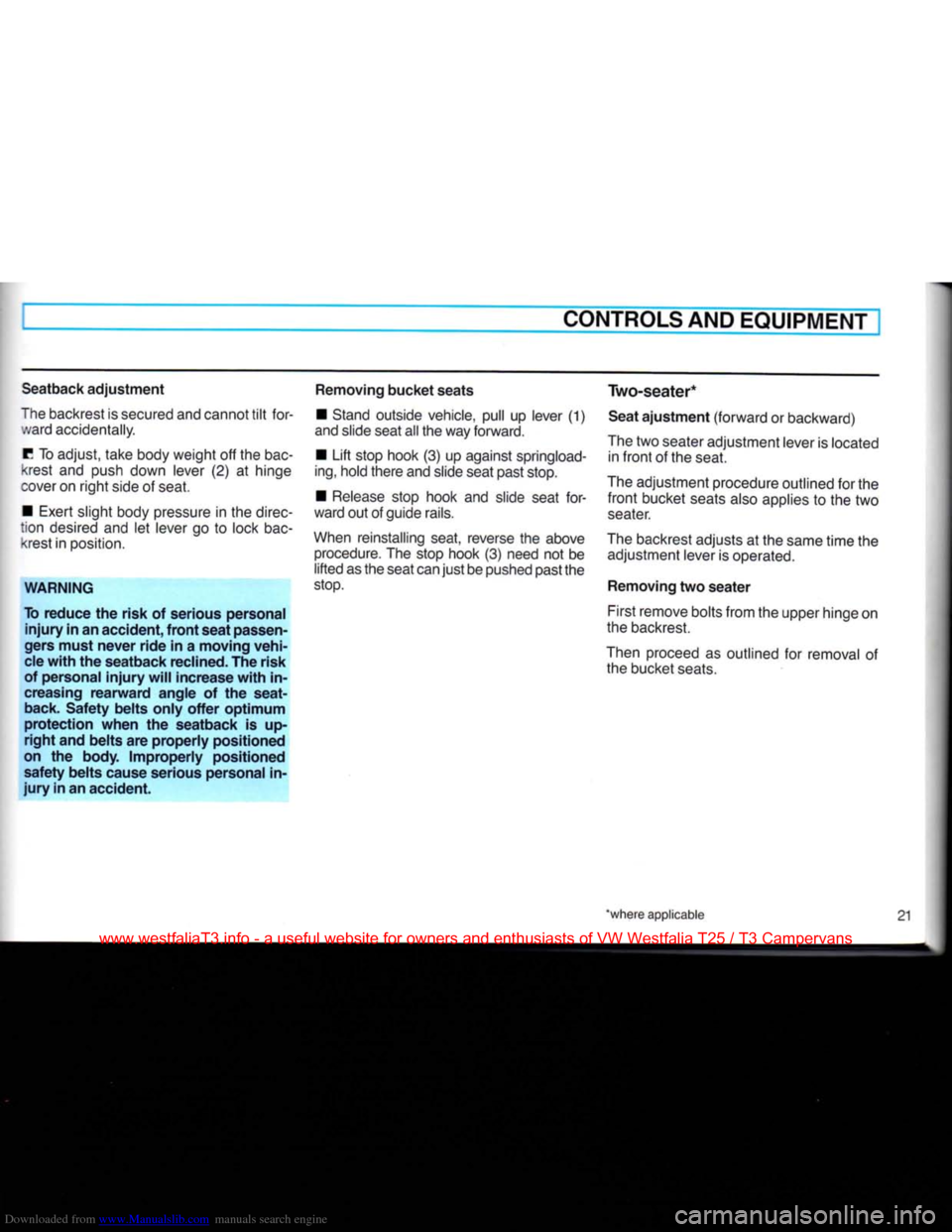
Downloaded from www.Manualslib.com manuals search engine
CONTROLS AND
EQUIPMENT
Seatback
adjustment
The backrest is secured and cannot
tilt
for
ward accidentally.
C
To adjust, take body weight off the
bac
krest and push down lever (2) at hinge
cover on
right
side of seat.
• Exert slight body pressure in the direc
tion
desired and let lever go to lock
bac
krest in position.
WARNING
To
reduce
the
risk
of
serious
personal
injury
in an
accident,
front
seat
passen
gers
must
never
ride
in a
moving
vehi
cle
with
the
seatback
reclined.
The
risk
of
personal
injury
will
increase
with
in
creasing
rearward
angle
of the
seat-
back.
Safety
belts
only
offer
optimum
protection
when
the
seatback
is up
right
and
belts
are
properly
positioned
on the
body.
Improperly
positioned
safety
belts
cause
serious
personal
in
jury
in an
accident.
Removing
bucket
seats
• Stand outside vehicle, pull up lever (1)
and slide seat all the way forward.
•
Lift
stop hook (3) up against springload-
ing,
hold there and slide seat past stop.
•
Release
stop hook and slide seat
for
ward out of guide rails.
When reinstalling seat, reverse the above procedure. The stop hook (3) need not be
lifted
as the seat can
just
be pushed past the
stop.
Two-seater*
Seat
ajustment
(forward
or backward)
The two seater adjustment lever is located in
front
of the seat.
The adjustment procedure outlined for the
front
bucket seats also applies to the two
seater.
The backrest adjusts at the same
time
the adjustment lever is operated.
Removing
two
seater
First remove bolts
from
the upper hinge on
the backrest.
Then proceed as outlined for removal of the bucket
seats.
*where applicable 21
www.westfaliaT3.info - a useful website for owners and enthusiasts of VW Westfalia T25 / T3 Campervans
Page 23 of 165
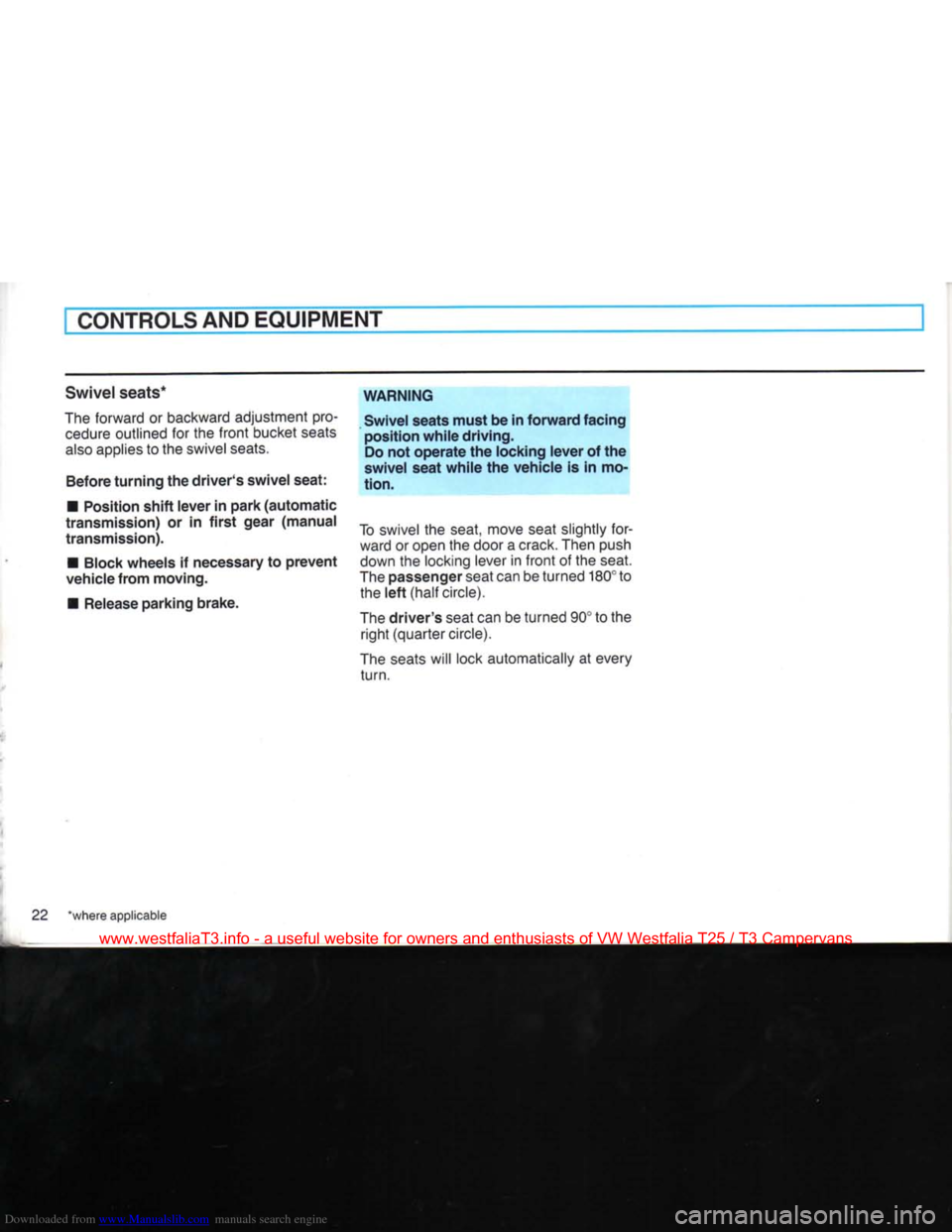
Downloaded from www.Manualslib.com manuals search engine
CONTROLS
AND
EQUIPMENT
Swivel seats*
The forward or backward adjustment pro cedure outlined for the
front
bucket seats
also
applies to the swivel seats.
Before turning the driver's swivel seat:
•
Position shift lever in park (automatic
transmission) or in first gear (manual
transmission).
•
Block wheels if necessary to
prevent
vehicle from moving.
•
Release parking brake. WARNING
Swivel seats must be in forward facing
position while driving. Do not operate the locking lever of the
swivel seat while the vehicle is in mo
tion.
To swivel the seat, move seat slightly for ward or open the door a crack.
Then
push
down the locking lever in
front
of the seat.
The passenger seat can be turned
180°
to the left
(half
circle).
The driver's seat can be turned
90°
to the
right
(quarter
circle).
The seats will lock automatically at
every
turn.
22
"where applicable
www.westfaliaT3.info - a useful website for owners and enthusiasts of VW Westfalia T25 / T3 Campervans